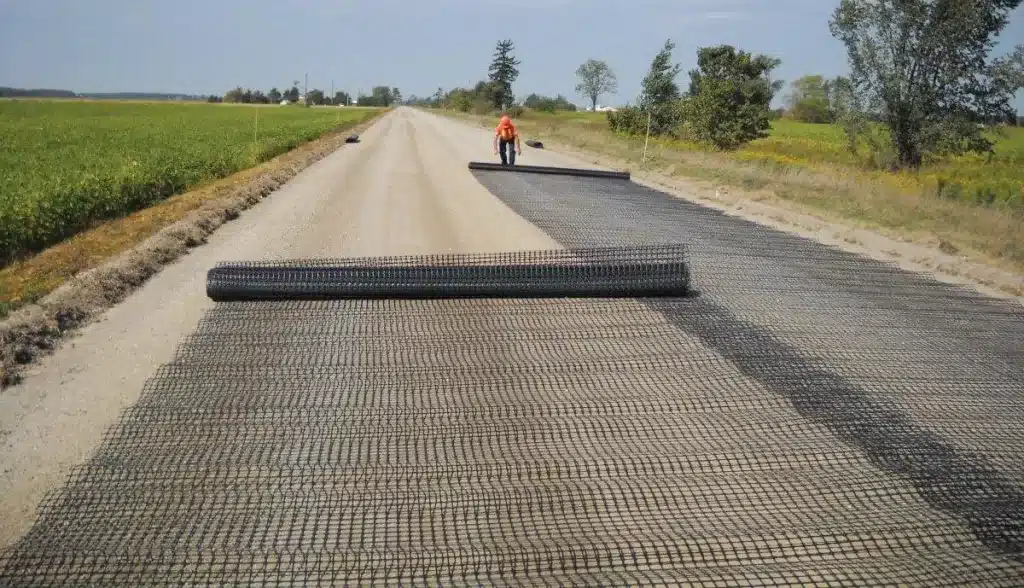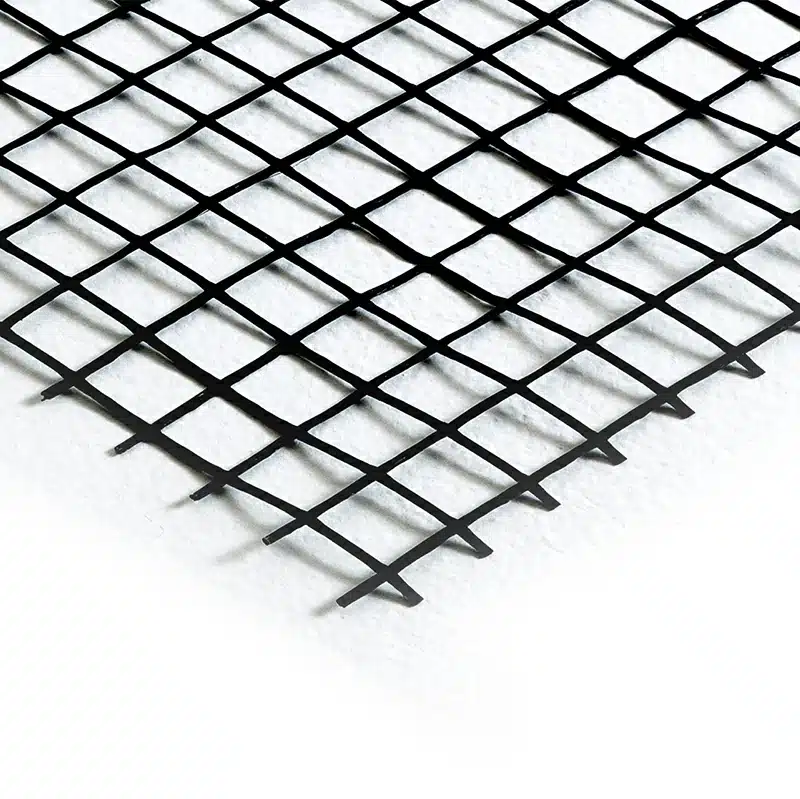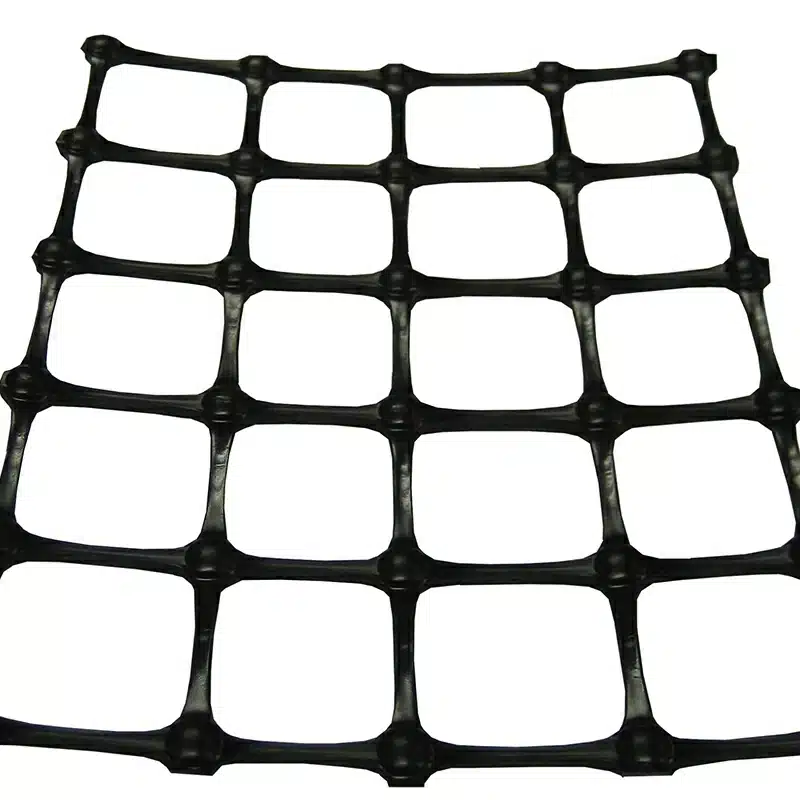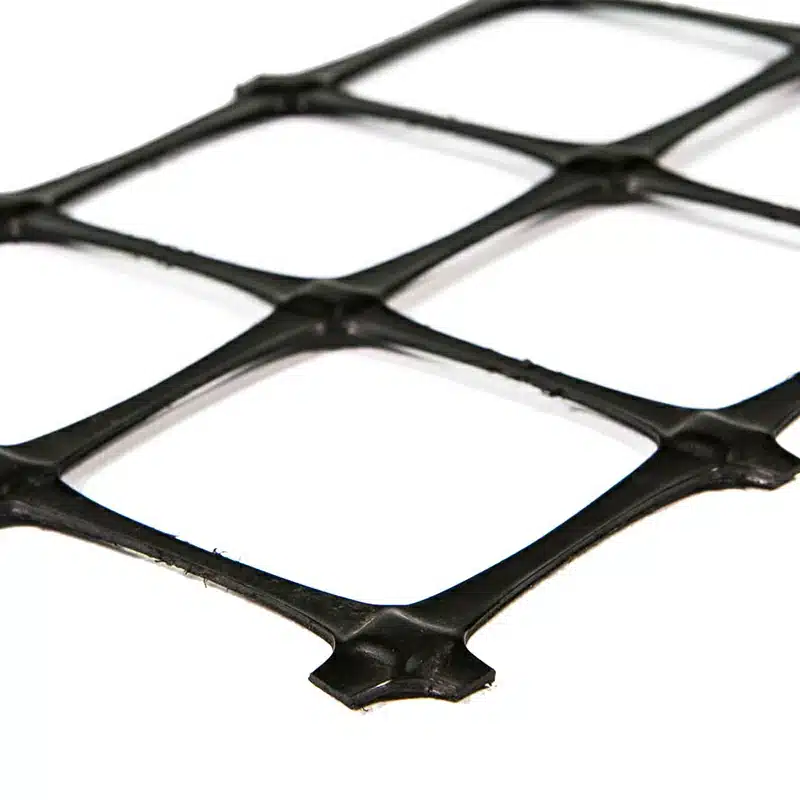+86-159 9860 6917
info@geofantex.com
geofantex@gmail.com
+86-400-8266163-44899
When it comes to soil stabilization and erosion control, geogrid and fabric are two commonly used solutions. In this article, we will explore the differences between geogrid and fabric, and their requirements to help you make an informed choice for your specific project.

What is Geogrid, and How Does It Work?
Geogrid is a geosynthetic material used in civil engineering and construction to reinforce soil. Made from polymers like polypropylene, polyester, or high-density polyethylene, it features a grid-like structure that allows it to interlock with soil and other materials.
How Geogrid Works:
- Reinforcement: The primary function of a geogrid is to reinforce soil. Its grid structure provides a framework that helps to stabilize soil by increasing its shear strength. This is particularly useful in constructing roads, retaining walls, and embankments where soil stability is crucial.
- Load Distribution: Geogrids distribute loads more evenly across a larger area. In road construction, for example, they help to spread the weight of vehicles, reducing stress on the underlying soil and preventing deformation or collapse.
- Soil Interlock: The open grid design of geogrids allows soil to penetrate through its apertures, creating an interlock mechanism. This interlocking enhances the overall stability of the soil-geogrid composite, making it more resistant to movement and erosion.
- Tension Resistance: Geogrids are designed to be highly tensile, meaning they can withstand significant pulling forces. This property is essential in applications where the material needs to resist stretching or tearing under load.
- Flexibility and Durability: Despite their strength, geogrids are relatively flexible, which allows them to conform to varying ground contours and withstand differential settlement without losing effectiveness. They are also durable, resistant to biological and chemical elements in the soil, ensuring longevity in their reinforcing role.
In summary, geogrids work by providing reinforcement, improving load distribution, and enhancing soil stability, making them a vital component in various construction and engineering projects where soil strength and durability are of concern.
What is Geofabric, and What Are Its Applications?
Geofabric, also known as geotextile, is a permeable fabric used in civil engineering and construction, made from synthetic materials like polyester or polypropylene. It comes in two main forms: woven and non-woven, each with specific properties and uses.
Applications of Geofabric:
- Soil Separation: Geofabric is used to separate different layers of soil, gravel, and stones, preventing them from mixing. This separation is crucial in road construction, where it prevents the intermixing of subgrade soil and the gravel base, maintaining the structure’s integrity.
- Erosion Control: It’s used to prevent soil erosion in areas susceptible to water or wind erosion. By covering soil surfaces, geo fabric prevents the displacement of soil particles, thus protecting the landscape and maintaining soil health.
- Drainage: Geofabric aids in drainage by allowing water to pass through while preventing soil erosion. This feature is particularly useful in the construction of retaining walls, drainage ditches, and landscaping to manage water flow and prevent waterlogging.
- Reinforcement: While not as robust as geogrids in terms of load distribution, geofabrics can still provide additional strength to soil, helping to stabilize embankments, slopes, and other earth structures.
- Filtration: In applications like road construction and drainage systems, fabric acts as a filter, allowing water to pass through while preventing soil and other particles from clogging drainage systems.
- Protection: It is used to protect geomembranes in landfill and pond lining applications. Geofabric prevents punctures or damage to these liners, ensuring their longevity and effectiveness.
- Landscaping: In landscaping, fabric is used to suppress weeds while allowing water and nutrients to reach plant roots. It’s also used in creating paths and retaining structures within gardens.
In summary, fabric is a versatile material in civil engineering and environmental projects, offering solutions for soil separation, erosion control, drainage, filtration, reinforcement, protection, and landscaping. Its ability to perform multiple functions makes it a valuable component in a wide range of construction and environmental applications.

What is the difference between Geofabric and Geogrid?
Geofabric and geogrid are both geosynthetic materials used in civil engineering and construction, but they have distinct differences in structure, material properties, and applications:
Structure and Material:
- Geofabric (Geotextile): Geofabrics are made from woven or non-woven synthetic fibers, typically polyester or polypropylene. Woven fabrics resemble regular textiles, while non-woven ones look more like felt. They are generally flexible and permeable, allowing water to pass through while filtering out finer soil particles.
- Geogrid: Geogrids are made from polymers like polypropylene, polyester, or high-density polyethylene and feature a grid-like, open structure. This design allows soil to interlock with the grid, providing reinforcement. Geogrids are more rigid compared to geofabrics.
Function and Application:
- Geofabric:
- Separation: Prevents mixing of different soil layers.
- Filtration: Allows water to pass while filtering out soil particles, preventing drainage systems from clogging.
- Erosion Control: Stabilizes soil surfaces against erosion.
- Protection: Protects geomembranes in landfills and pond linings.
- Drainage: Facilitates the removal of water from soil.
- Geogrid:
- Reinforcement: Primarily used for reinforcing soil, especially in road and railway construction, and in retaining walls.
- Load Distribution: Helps distribute loads over a wider area, improving the stability and strength of the soil.
- Soil Stabilization: Stabilizes slopes, embankments, and other earth structures.
Performance Characteristics:
- Geofabric: Offers flexibility, good filtration, and separation properties. It’s effective in scenarios where water management and soil filtration are crucial.
- Geogrid: Provides superior tensile strength and load distribution capabilities. It’s more suitable for applications requiring significant soil reinforcement and stabilization.
In summary, while both geofabric and geogrid are used in similar domains, geofabric is more about separation, filtration, and protection, whereas geogrid is focused on soil reinforcement and stabilization. The choice between the two depends on the specific requirements of the construction or engineering project.
Can I use both Geogrid and Geofabric together?
Yes, you can use both geogrid and fabric together in many construction and engineering projects. Combining these materials often leverages the strengths of each, leading to enhanced performance and durability of the engineered structure. Here’s how they can complement each other:
- Layered System: In applications like road construction, a layered system can be created where fabric is used at the bottom layer for separation and filtration, preventing the mixing of subgrade soil with the gravel or aggregate layer. Above this, a geogrid can be placed to provide reinforcement and load distribution.
- Erosion Control and Slope Stabilization: For slope stabilization and erosion control, fabric can be used to prevent soil erosion and promote vegetation growth, while geogrid can provide structural stability to the slope.
- Retaining Walls: In the construction of retaining walls, fabric can be used to facilitate drainage and prevent the buildup of hydrostatic pressure, while geogrids can reinforce the soil, enhancing the overall stability of the wall.
- Drainage Systems: In drainage applications, fabric can act as a filter layer to prevent the clogging of drainage channels with fine soil particles, while geogrid can provide structural support to the drainage system.
- Pavement Construction: For pavement construction, the combination can be particularly effective. Geofabric can act as a separator and filter, while geogrid can reinforce the base and sub-base layers, improving load-bearing capacity and extending the pavement’s lifespan.
When using both materials together, it’s important to consider the specific properties and installation requirements of each. The design should ensure that the functions of both materials are optimized without compromising their individual performance. Proper overlap, anchoring, and layering techniques are crucial for the effectiveness of the combined system. Consulting with a civil engineer or a geosynthetic specialist can provide guidance on the best practices for using geogrid and fabric together in a particular project.
In conclusion, the choice between Geogrid and Geofabric depends on the specific requirements of your project. Geogrids offer structural support and load distribution, while Geofabrics excel in erosion control and soil preservation. Analyzing your site conditions and design goals will help you make an informed decision, ensuring the success of your soil stabilization and erosion control project.



Get Free Sample
We’ll respond as soon as possible(within 12 hours)




















